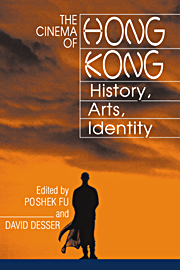Book contents
- Frontmatter
- Contents
- List of Contributors
- Acknowledgments
- Introduction
- Chronology of Hong Kong Cinema
- PART I HISTORY
- 1 The Kung Fu Craze: Hong Kong Cinema's First American Reception
- 2 The American Connection in Early Hong Kong Cinema
- 3 The 1960s: Modernity, Youth Culture, and Hong Kong Cantonese Cinema
- 4 The 1970s: Movement and Transition
- PART II ARTS
- PART III IDENTITY
- Index
2 - The American Connection in Early Hong Kong Cinema
Published online by Cambridge University Press: 05 June 2012
- Frontmatter
- Contents
- List of Contributors
- Acknowledgments
- Introduction
- Chronology of Hong Kong Cinema
- PART I HISTORY
- 1 The Kung Fu Craze: Hong Kong Cinema's First American Reception
- 2 The American Connection in Early Hong Kong Cinema
- 3 The 1960s: Modernity, Youth Culture, and Hong Kong Cantonese Cinema
- 4 The 1970s: Movement and Transition
- PART II ARTS
- PART III IDENTITY
- Index
Summary
Cinema activities in Hong Kong may be traced back to the late 1890s. However, primary materials related to those early activities, particularly before the 1920s, are extremely scarce. As elsewhere in China, the early film industry in Hong Kong was generated by Western businessmen who either came to the Far East for that purpose or seized their opportunities to establish theatres and make films.
As cinema was an imported art form, and technically a new one, it took some time for Hong Kong artists to adjust to the new medium. When a film industry eventually emerged in the 1920s, it turned to the live theatre for material and personnel because theatre had been the traditional form of mass entertainment in China for centuries. It continued as such for far longer than in the West. Hong Kong cinema would have its first “golden age” between 1937 and 1941, quite suddenly achieving a very high output – peaking at the 125 films produced in 1939 – and a diversity of genres that had never appeared before. This extremely fertile period is important to researchers of the earliest developments in the industry, as stimulated by two key factors, which are examined in this chapter.
The first factor was the “American experience” of the film pioneers – not so much in their exposure to Hollywood films as in their having worked with Americans or lived in the United States.
- Type
- Chapter
- Information
- The Cinema of Hong KongHistory, Arts, Identity, pp. 44 - 70Publisher: Cambridge University PressPrint publication year: 2000
- 14
- Cited by



